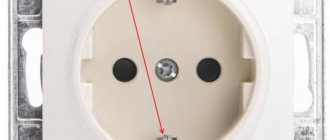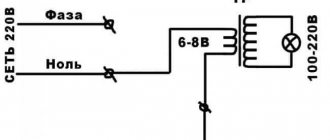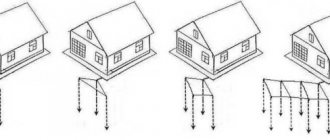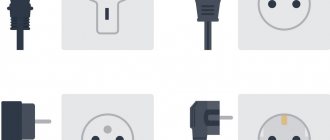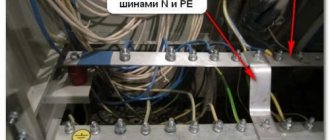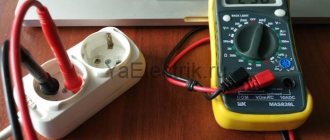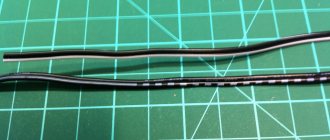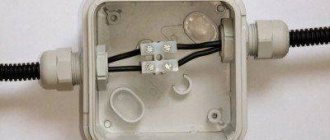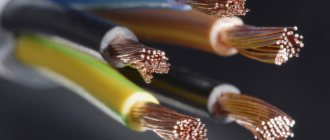How to visually determine the identity of the wires in a socket
Painting core insulation in specific colors is a way of marking electrical wires. This is done to visually determine the purpose of a particular conductor. This method of determining the purpose is the most visual and convenient for electricians. Manufacturers also apply letter markings. It is also marked in electrical circuits or on devices.
The marking of electrical wires does not have strict regulations, so the colors may not match.
In single-phase current networks
Electrical wiring with a single-phase 220 V network has 2 cores. One is phase, the other is zero. The color coding is usually as follows:
- phase – brown, black, gray, red, turquoise or other color;
- zero – blue.
According to generally accepted markings, the phase conductor can be painted in any color except blue. The zero core is traditionally painted blue or light blue.
A single-phase three-wire network has 3 cores. There is a neutral, phase and grounding conductor. The presence of grounding is one of the main requirements in the installation rules.
The marking of the phase electrical wire is brown, the neutral wire is blue or light blue, the ground wire is yellow-green.
In three-phase current networks (three-wire)
A three-phase 380 V network can be with or without a grounding conductor.
There are three-phase four-wire and five-wire networks. A network with four conductors contains 3 phase conductors and one zero working conductor. There is no grounding.
The neutral conductor is necessarily indicated in blue or cyan; any other color can be used for the phase.
The five-wire network is grounded. It is traditionally indicated by a yellow-green color. The coloring of the remaining wires is similar: zero is blue, phases are of other colors. Typically, phase conductor A is brown, B is black, and C is gray.
What is the difference between phase and zero?
The AC network is divided into two components: the working phase and zero. The phase is supplied with operating voltage. Zero is necessary to create a continuous electrical network. A grounding conductor is also used. It is intended to protect people from electric shock.
Modern homes use a three-phase electricity supply system, consisting of three phases and one neutral. In each phase, the supplied current shifts by 120 degrees. The neutral conductor compensates for uneven load. In its absence, a different voltage is created at each load, which leads to breakdown of electrical equipment.
Connecting a double socket with grounding
The procedure for connecting a double socket is exactly the same as for a regular socket, if it is a model for one socket. It has one grounding contact for both sockets, so the part that is inserted into the socket box is no different from the standard device.
It’s another matter if a double socket is made up of two ordinary ones located next to each other. In this case, grounding should be considered as made for two separate points and the installation of the grounding wire is carried out somewhat differently than phase and neutral.
The difference is that often the connected block of sockets is connected to each other by a cable, when the wires go to the next point from the contacts of the previous one. If a wire burns out in any place, the next sockets in the circuit will not work. This is not a potential shock hazard like a ground wire that fails.
To avoid this, before connecting a double socket made from ordinary ones, the grounding wire is laid in one piece to the last connection point, and twists are made opposite the previous ones, from which the grounding is already applied to the grounding contacts.
If there is no ground wire in the outlet
It all depends on where exactly you need to connect the outlet with grounding - in a private house or an apartment building. In the second case, you still need to find out whether there is a grounding bus in the floor panel - the situation may well be the opposite of the previous one - when the wiring in the apartment is old, and the floor panel has already been converted to new standards and has a bus for connecting a PE conductor.
If there is no grounding bus in the floor panel, then you will not be able to ground the outlets yourself. More precisely, it can be done, but it will be a violation - interference with the approved layout of the house, etc.
As a result, if there is no grounding, then all the residents of the house need to get together and write a collective statement so that the housing office employees carry out all the necessary work. There are no other options to do everything legally.
Also, the choice of connection method depends on whether you need to ground one outlet or ground all of them in the apartment. If one outlet can be grounded using external wiring, then if it is necessary to remodel all points in the apartment, large-scale work will have to be carried out to replace the electrical wiring, which is usually done only during major repairs.
They consist of removing the old wiring from the wall and installing a new one in its place, which, among other things, will also have a grounding wire. In this case, it is not worth considering the option of simply adding a grounding conductor.
The wiring itself is most likely old, plus, there is usually no precise wiring diagram inside the wall, so making new grounding grooves without damaging the old wires is quite problematic.
Designations and explanation
Conductors have not only color, but also letter markings.
Latin letters indicate the corresponding cores in circuits and equipment. Additional information may also be indicated on the cable: cross-section, length, brand and other necessary parameters.
Phase wire L
The letter designation of the phase conductor is written as L (line). If there are several phases, a number next to the letter is additionally noted - L1, L2. The color of the phase cable can be anything except blue (cyan) and yellow-green.
Zero worker N
The letter N (neutral) denotes the neutral or middle conductor. It is painted in blue shades. Until 2000, the color marking of the zero was white.
Zero protective PE
The Latin letters PE (protect earth) represent the neutral grounding conductor. The designation PEN is also found - this is typical for the classic combination of wires, biased to zero. Similar markings are found in TN-CS systems. The color of the vein is yellow-green.
Color of zero, neutral
The “zero” wire should be blue
. In the distribution board it must be connected to the zero bus, which is designated by the Latin letter N. All blue wires must be connected to it. The bus is connected to the input via a meter or directly, without additional installation of the machine. In the distribution box, all wires (except for the wire from the switch) of blue color (neutral) are connected and do not participate in switching. To the sockets, the blue “zero” wires are connected to the contact, which is designated by the letter N, which is marked on the back of the sockets.
Colorless flat three-core wires when installing PPV: how to determine?
It is possible to determine the phase and neutral conductors not by markings.
This is done using an indicator screwdriver or a multimeter. Finding a phase core using an indicator is quite simple. You need to touch the controlled section of the circuit with the conductive tip of a screwdriver.
You need to touch the contact pad with your finger. If the indicator lights up, then the tested core is a phase. Otherwise it is zero.
It is prohibited to hold onto the metal part of the screwdriver when checking!
Checking with a multitester is labor-intensive, but it provides complete information. To find the phase, you will need a natural grounding conductor - a heating radiator, a metal pipe. The multimeter is switched to AC voltage measurement mode. The limit is above 220 V. Touch the conductor with one tester probe and the ground electrode with the other. When the display shows a voltage close to the mains voltage (220 V), then the phase conductor has been found.
The multimeter shows that there is no phase. This is due to the fact that the circuit is open. When closed, the phase will appear.
The multimeter also finds the neutral and ground conductors. To do this, it is first determined where the phase is located.
Move the tester to the position of checking alternating voltage with a limit above 220 V. In turn, you need to measure between a phase and another conductor. The larger number is the value between the phase and the working zero, the smaller number is between the phase and ground conductor. This method is rarely used; it is better to find the ground by marking and connecting to the ground contacts.
You can also find the phase cable using a light bulb by screwing it into the socket. Find 2 pieces of electrical wires with bare ends - one is grounded. Touch the wire with the other end. If the lamp lights up, then this is the working phase.
Wire Specifications
The main indicators of PVZ can be classified into mechanical, thermal and electrical. Using the presented characteristics, you can easily determine the operability of the conductor, in particular:
- The main indicator is the flexibility of the product. The permissible radius (size) of a cable determines the amount at which a given conductor can be bent without risk of damage. The specified parameter is checked immediately after the product is manufactured.
- Temperature has a strong influence on the performance of the conductor, so when laying the product you need to pay attention to this characteristic. For example, the question often arises at what temperature a conductor of the PVZ type cannot be laid. Electrical installation work can be carried out at temperatures from -50 to +50 degrees.
- An emergency situation may cause short-term overheating. If problems occur, this indicator can reach +150 degrees. In addition, good insulation helps maintain dielectric and mechanical parameters.
- How many single impacts can the insulating layer withstand? This indicator is important for communication lines, as well as when working with specific equipment.
- The main property of a conductor is its insulation resistance. This parameter depends on the cross-section and temperature conditions. To check the indicator, the wire is immersed in water for 2-3 minutes. Subsequent voltage supply is 2.5 kV.
Why is it impossible to determine phase and zero by wire color?
According to the requirements of the PUE, conductors have their own color marking.
It is not recommended to rely 100% on this method of determination. The cables may have been mixed up at the factory, so we recommend checking them. When doing the work yourself, you can mark the purpose of the wires, especially if they are colorless.
To do this, you need to purchase heat-shrinkable tubes or electrical tape of different colors. In accordance with the rules, it is allowed to do independent marking not along the entire length of the electrical wire, but only at the connection points. The tube or insulating tape must be secured to the corresponding conductor and write down which color belongs to which conductor.
Non-standard wires and markings
When purchasing a new wire, you will, of course, pay attention to the color marking of the cores and choose the option where it is applied correctly. What to do if the wiring has already been completed, but the colors of the wires do not meet the requirements of GOST? The output in this case is the same as with PEN wires. You will have to perform manual marking after you have decided on the role played by the conductors suitable for the equipment. A simple option would be to use colored electrical tape in appropriate shades. At a minimum, it is worth identifying the protective and neutral wires.
During professional installation, it is possible to use special cambrics, which are hollow pieces of insulating material. They are divided into regular and heat-shrinkable. The latter do not require selection by diameter, but do not have the possibility of reuse.
There are also specially made markers with international alphanumeric designations. They are used on input and distribution boards, for example, in apartment buildings or administrative buildings.
Digital tags, together with the color of the wire, allow you to determine which consumer is supplied with power.
Is ground always indicated by a green-yellow wire?
It looks like yellow insulation with longitudinal bright green stripes. Sometimes there is a coloration of transverse stripes. Sometimes the grounding electrical wire is marked with a yellow or green tint. A similar designation should be on the diagram.
Conductors manufactured before 2000 were color coded differently. According to it, grounding was indicated in black.
Identification of electrical wires is a mandatory step before starting electrical installation work. If you confuse the phase, neutral and grounding conductors, equipment failure, electrical wiring failure, or even a fire in the apartment may occur. There are several ways to find out which core is responsible for what. The first is based on the color of the conductor insulation. This is a common method. The second is by letter marking. If the electrical wire is colorless, you can find out the purpose of the wires using an indicator screwdriver, a multimeter or a light bulb.
